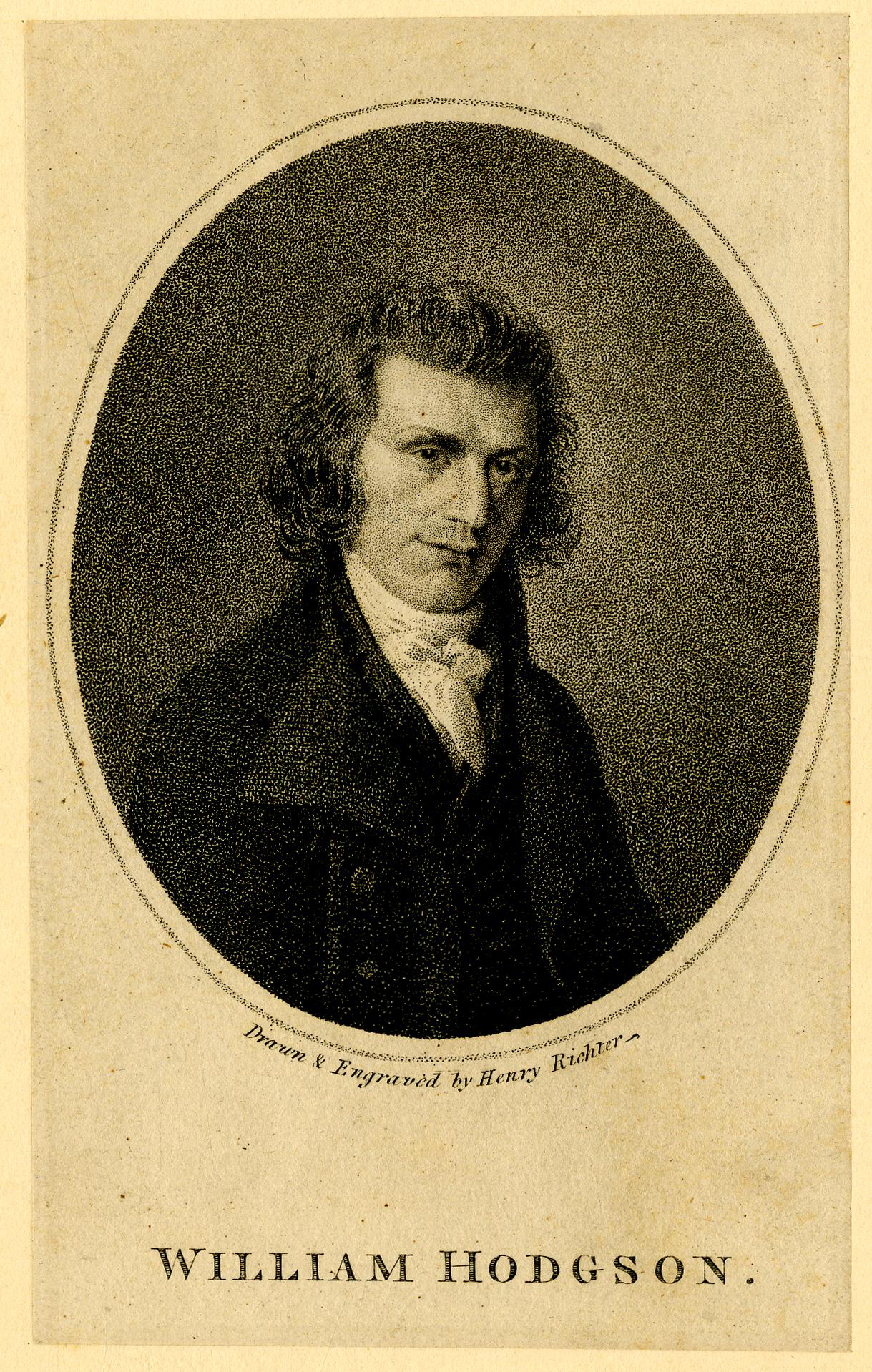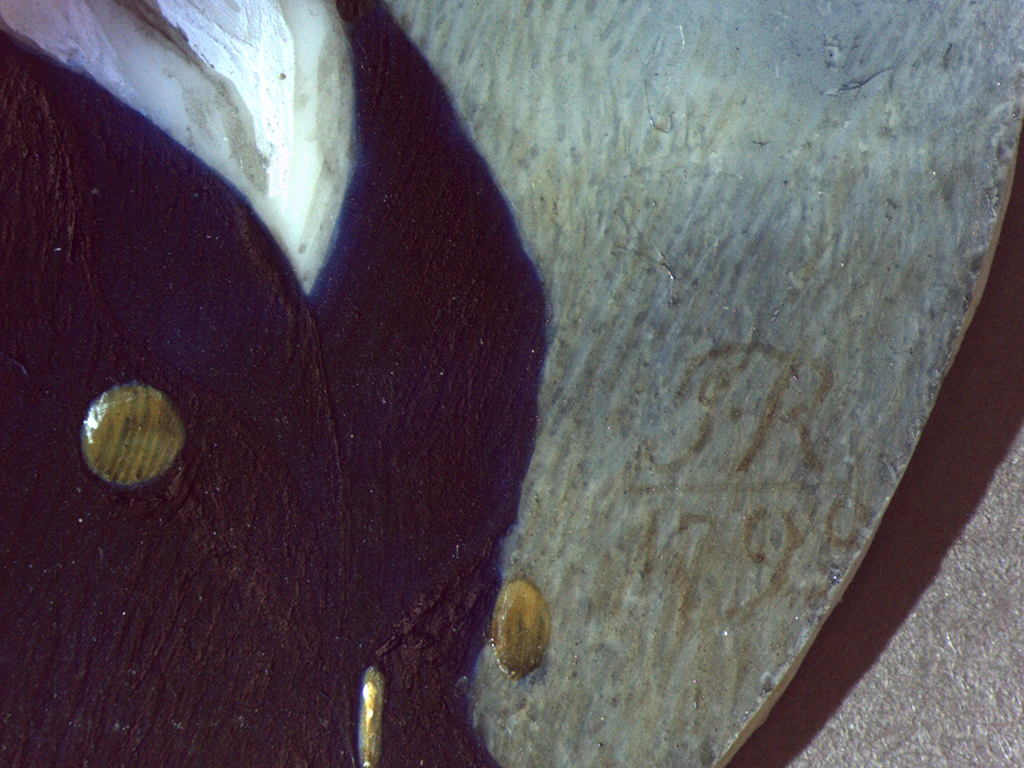Citation
Chicago:
Maggie Keenan, “Unknown, Portrait of a Man, 1799,” catalogue entry in Aimee Marcereau DeGalan, Blythe Sobol, and Maggie Keenan, The Starr Collection of Portrait Miniatures, 1500–1850: The Collections of the Nelson-Atkins Museum of Art, vol. 3, ed. Aimee Marcereau DeGalan (Kansas City, MO: Nelson-Atkins Museum of Art, 2024), https://doi.org/10.37764/8322.5.1680.
MLA:
Keenan, Maggie. “Unknown, Portrait of a Man, 1799,” catalogue entry. Aimee Marcereau DeGalan, Blythe Sobol, and Maggie Keenan. The Starr Collection of Portrait Miniatures, 1500–1850: The Collections of the Nelson-Atkins Museum of Art, edited by Aimee Marcereau DeGalan, vol. 3, Nelson-Atkins Museum of Art, 2024. doi: 10.37764/8322.5.1680.
Catalogue Entry
Questions surrounding the signature on this miniature have led to a host of possible artist attributions. The miniature was ascribed to Thomas Richmond (1771–1837) at the time of its accession into the Nelson-Atkins collections, presumably due to its “T.R” inscription. However, closer stylistic inspection (see, for example, Richmond’s Portrait of a Man, F58-60-117) and the fact that Richmond historically did not sign the front of his work, discourages this attribution. Further examination of the cursive “T.R,” aided by new photomicrographs: A photograph taken with the aid of a microscope. of the miniature, introduced the possibility of a “J.R” signature. Initial research into miniaturists with these initials brought forth the name John Robinson (ca. 1774–1829), who signed his work with a cursive “JR.” While his inscription on an 1816 portrait shares the same looping “J” and a similarly slanted “R,” none of Robinson’s early portraits have been identified, so no stylistic comparisons can be drawn.1Robinson studied under Benjamin West (American, 1738–1820) and moved from London to Pennsylvania around 1816. When compared to his identified works from 1816 and 1822, the present miniature does not share the same color palette, attention to the background, or other details. See Daphne Foskett, “John Robinson,” Miniatures: Dictionary and Guide (Woodbridge: Antique Collectors Club, 1987), 631. John Robinson’s portrait of Benjamin West, 1816, which sold at auction in 2008, is now at the Pennsylvania Hospital in Philadelphia, where West’s Christ Healing the Sick (1817) is located. Elle Shushan to the author, September 23, 2021, Nelson-Atkins curatorial files.

Additionally, “J.R” may suggest the hand of English artist Henry James Richter (1772–1857), whose engraving of one William Hodgson at the British Museum bears a direct resemblance to the Nelson-Atkins portrait, particularly in the shape of the nose and mouth, as well as the almond-shaped eyes and prominent browbone (Fig. 1).2Dennis Read, R. H. Cromek, Engraver, Editor, and Entrepreneur (Farnham: Ashgate, 2011), 45; According to Foskett in “Henry James Richter,” 627, Richter was a painter of miniatures and historical subjects, but he primarily worked as an engraver. However, as with Robinson, none of Richter’s miniatures have been identified, and in an 1823 oil painting his signature was “H. Richter.”3See Henry James Richter, The New Gown, 1823, oil on panel, 31 11/16 x 25 3/8 in. (80.5 x 64.5 cm), sold at Bonhams, “Fine Art & Antiques, including Silver,” December 3, 2014, lot 303. We know Richter painted portrait miniatures because he taught John Sartain (American, 1808–1897) the practice. If the artist were Richter, then he would have been twenty-seven years old at the time of its completion and working at the popular 26 Newman Street, or the “Artists Street,” in London. His neighbors in the two-block radius included his tutor Thomas Stothard (English, 1755–1834), West, Ozias Humphry (English, 1742–1810), and others. He was busy in the 1790s drafting illustrations and engravings for novels, including Bernardin de Saint-Pierre’s Paul and Virginia in 1799. Foskett, “Henry James Richter,” 627. The faded condition of the Nelson-Atkins miniature, as well as the interchangeability of cursive T’s and J’s, makes this inscription nearly impossible to confirm. The painting’s date has also changed recently; previously thought to be 1798, photomicrographs provide a clearer image of a 1799 date (Fig. 2).

The sitter’s clothing is typical of the late eighteenth century. He wears a jacket with a large turned-down collar and a thick, tucked-in cravat: A cravat, the precursor to the modern necktie and bowtie, is a rectangular strip of fabric tied around the neck in a variety of ornamental arrangements. Depending on social class and budget, cravats could be made in a variety of materials, from muslin or linen to silk or imported lace. It was originally called a “Croat” after the Croatian military unit whose neck scarves first caused a stir when they visited the French court in the 1660s., which gives his chest some added cushion and creates the appearance of buttons dangling in the air by threads. The artist generalized his sitter’s auburn hair with thick washes of brown paint, contrasting with a more detailed treatment of his eyebrows and sideburns. The sky background and the shadows of the man’s face contain thin diagonal brushstrokes. The facial features are convincing, particularly the thickness of his orange-tinted eyebrows, the slight curve atop the brim of his nose, and the “m” shape of his top lip.
A memento on the portrait’s case back, not necessarily original to the portrait, indicates that this may have been a piece of mourning jewelry. The memento contains gold wire decorations and a lock of hair cinched with a band of five seed pearls that, in portrait miniatures, often signified tears.4Julie Aronson and Marjorie Weiseman, Perfect Likeness: European and American Portrait Miniatures from the Cincinnati Art Museum (New Haven: Yale University, 2006), 67. According to a May 30–June 2, 2017, conversation with conservator Carol Aiken, the memento’s pearls appear to originate in the correct period; Nelson-Atkins curatorial files. Although jewelers or hairworkers: The individuals who created hair art. frequently used purchased hair rather than the sitter’s own, the hair memento acted as an immortal token, bringing to life the painting’s flat depiction.5Aronson and Weiseman, Perfect Likeness, 69.
Notes
-
Robinson studied under Benjamin West (American, 1738–1820) and moved from London to Pennsylvania around 1816. When compared to his identified works from 1816 and 1822, the present miniature does not share the same color palette, attention to the background, or other details. See Daphne Foskett, “John Robinson,” Miniatures: Dictionary and Guide (Woodbridge: Antique Collectors Club, 1987), 631. John Robinson’s portrait of Benjamin West, 1816, which sold at auction in 2008, is now at the Pennsylvania Hospital in Philadelphia, where West’s Christ Healing the Sick (1817) is located. Elle Shushan to the author, September 23, 2021, Nelson-Atkins curatorial files.
-
Dennis Read, R. H. Cromek, Engraver, Editor, and Entrepreneur (Farnham: Ashgate, 2011), 45; According to Foskett in “Henry James Richter,” 627, Richter was a painter of miniatures and historical subjects, but he primarily worked as an engraver.
-
See Henry James Richter, The New Gown, 1823, oil on panel, 31 11/16 x 25 3/8 in. (80.5 x 64.5 cm), sold at Bonhams, “Fine Art and Antiques, including Silver,” December 3, 2014, lot 303. We know Richter painted portrait miniatures because he taught John Sartain (American, 1808–1897) the practice. If the artist were Richter, then he would have been twenty-seven years old at the time of its completion and working at the popular 26 Newman Street, or the “Artists Street,” in London. His neighbors in the two-block radius included his tutor Thomas Stothard (English, 1755–1834), West, Ozias Humphry (English, 1742–1810), and others. He was busy in the 1790s drafting illustrations and engravings for novels, including Bernardin de Saint-Pierre’s Paul and Virginia in 1799. Foskett, “Henry James Richter,” 627.
-
Julie Aronson and Marjorie Weiseman, Perfect Likeness: European and American Portrait Miniatures from the Cincinnati Art Museum (New Haven: Yale University, 2006), 67. According to a May 30–June 2, 2017, conversation with conservator Carol Aiken, the memento’s pearls appear to originate in the correct period; Nelson-Atkins curatorial files.
-
Aronson and Weiseman, Perfect Likeness, 69.
Provenance
Lewis Charles Wallach (1871–1964), The Grange, Northington, Hampshire, by May 2, 1955 [1];
Purchased from his sale, Catalogue of Fine Portrait Miniatures, Sotheby’s, London, May 2, 1955, lot 58, as by Thomas Richmond, A Miniature of a Man, by Leggatt Brothers, London, probably on behalf of Mr. John W. (1905–2000) and Mrs. Martha Jane (1906–2011) Starr, Kansas City, MO, 1955–1958 [2];
Their gift to The Nelson-Atkins Museum of Art, Kansas City, MO, 1958.
Notes
[1] The 1955 sale catalogue lists, “The Property of L. C. Wallach, Esq. The Grange, Northington, Hants” for lots 46-94.
[2] Described in the catalogue as “A Miniature of a Man by Thomas Richmond, signed and dated 1798, three-quarters sinister, gaze directed at spectator, curly hair, white cravat and blue coat, 2 3/8 in.; and another of a Young Officer, full face, in red uniform with green facings, cloud and sky background, oval, 3 in., fitted case. Thomas Richmond was the pupil and cousin of George Engleheart.” Lot 58 contains two miniatures. The other, by an unknown artist, is also in the Nelson-Atkins collection; see F58-60/160. An annotated catalogue for this sale is located at University of Missouri-Kansas City, Miller Nichols Library, and it was likely annotated by Mr. or Mrs. Starr. “£20” is written in pencil to the left of lot 58 and is underlined in pen. According to the price list, Leggatt bought the lot for £20. Archival research indicates that the Starrs purchased many miniatures from Leggatt Brothers, either directly or with Leggatt acting as their purchasing agent.
References
Catalogue of Fine Portrait Miniatures (London: Sotheby’s, May 2, 1955), lot 58, as by Thomas Richmond, A Miniature of a Man.
Ross E. Taggart, The Starr Collection of Miniatures in the William Rockhill Nelson Gallery (Kansas City, MO: Nelson Gallery-Atkins Museum, 1971), no. 195, p. 66, (repro.), as Unknown Man.
No known related works or exhibitions at this time. If you have additional information on this object, please tell us more.